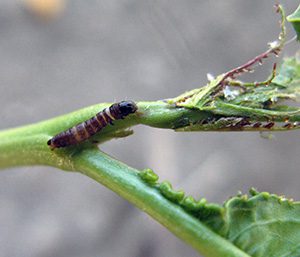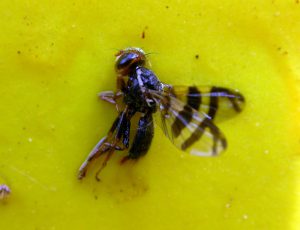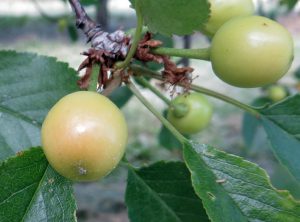In this Issue
- Codling moth: updated spray dates table
- Peach twig borer: spray dates for more Utah locations
- Western cherry fruit fly: treatment should start when fruits turn salmon blush color
APPLE, PEAR
Codling Moth
Codling moth treatment dates of “greatest egg hatch” are coming up for northern Utah locations.
View a pdf of the spray timing table. Be sure to read the instructions at the top of the page, for how to read the table. If you are late on the spray, or want to spray minimally, focus on keeping fruit protected during the “period of greatest egg hatch” window. This is when about 75% of all the eggs hatch for the first generation of larvae.
Treatment
PEACH/NECTARINE, APRICOT
Peach Twig Borer
Treat in the next week in northern Utah locations

View a pdf of the spray timing table.
Peach twig borer affects peaches, nectarines, and apricots. Unlike codling moth on apples, this pest is more sporadic in Utah, and some locations have a low enough population that does not need to be treated.
The treatment table shows when to start treating the first generation for additional northern Utah locations. In general, just a single application is sufficient for the first generation. This spray will lower the population, and prevent shoots from being attacked.
But during the second generation (which can attack the fruit), you may need to apply insecticide regularly so that your tree is protected throughout the egg-hatch period.
Treatment
- Commercial: For options, click here.
- Residential: Treatment options are the same as for codling moth.
CHERRY
Western Cherry Fruit Fly

Western cherry fruit flies have been captured in Kaysville, UT, in the last few days. The traps are in an orchard with a very high population, so it is the earliest site that we see them active in northern Utah.
The time to treat for the “worms in the cherry” is based on the development of your own tree. Watch the fruit color. It will go from green to yellow, and then quickly develop a rosy blush. Once that rosy blush forms, then the female flies are able to penetrate the fruit skin and lay eggs inside.
Therefore, treatment should begin as soon as cherries develop a salmon blush color. Base this off the fruits in the sunniest location of the tree, which is often toward the top or on the outside edges.
Treatment Options – Backyard Growers
Conventional:
- Malathion (malathion): every 7 days
- Ortho Flower, Fruit, and Veg. (acetamiprid): Only the concentrate container includes cherry on the label; apply every 14 days
- Sevin, Bonide Fruit Tree Spray (carbaryl): every 14 days
- Spectracide Triazicide (gamma-cyhalothrin): every 14 days

Organic:
- Fertilome / Gardens Alive / Bull’s Eye / Monterey (spinosad): every 7 days
- Safer BioNEEM (azadirachtin): every 7 to 10 days
Treatment – Commercial Growers
- Commercial growers, click here.
